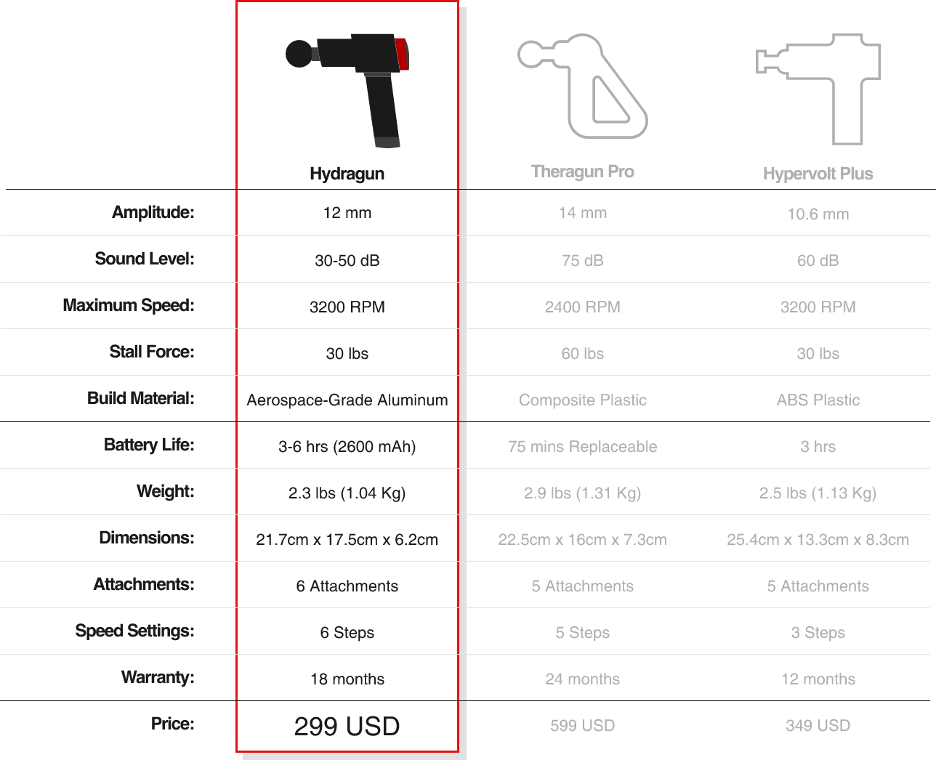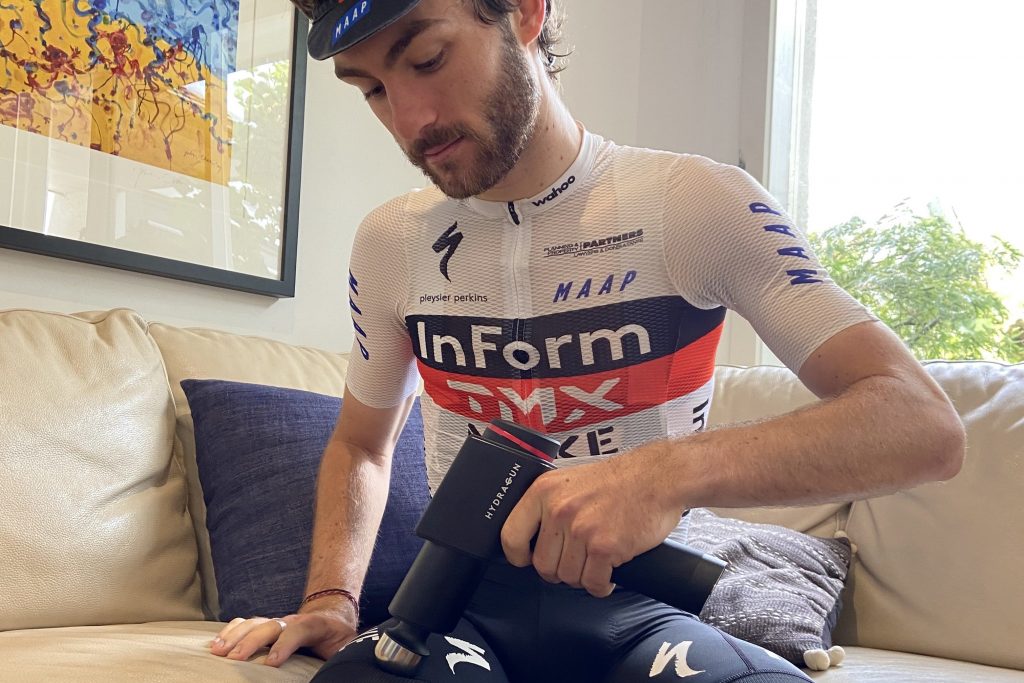Massage guns have been a hot topic in the world of recovery, but do they work? As an Exercise and Sport Science student that rides for a National Road Series cycling team here in Australia, I was a bit skeptical about the effectiveness of such products. I viewed them as more of a gimmick! But now my perspective has changed! So in this article I will be sharing with you my experiences using the Hydragun for sports recovery – notably cycling recovery – while outlining some scientific backed studies, which validate my antidotal experience.
Please note – while Hydragun supplied the Road Cycling Academy massage gun for a review, I have the freedoms to write from a blank canvas. Thus, they will be reading this review at the same time as you.
About the Gun
The Hydragun is priced at a modest $399 AUD, significantly cheaper than its major competitors with the Therabody Theragun Pro ($899) and the Hyperice Hypervolt Plus ($699.95). Although it’s about half the price of its major competitors, it doesn’t lack on paper performance. In fact, the Hydragun is possibly better on paper.

How Hydragun Compares with the Competition, from hydragun.com.au
The Hydragun is made from space grade aluminium to give it a high quality feel and sleek appearance. Hydragun claims this aids with noise reduction, boasting a super quiet 30-50db (or quieter) than a normal conversation (60db).
Aluminium is also used to improve heat dispensation and increase durability over their plastic counterparts. The handle is wrapped in a non-slip silicone that won’t go sticky when mixed with sweat.
The design is simple, featuring a single button to toggle through the six different power modes on offer. At its max setting, the Hydragun operates at a rapid 3200rpm and produces a stall force of 30lbs (or 13.6kg). The motor head also has an amplitude (or distance travelled) of 12mm.
The Hydragun utilises a 2600mAh battery producing up to 6 hours of battery life meaning you rarely have to reach for the charger.
The Hydragun has a 10 minute auto cut-off timer designed to protect the internal motors from overuse. They claim this should allow plenty of time to massage both legs, however, I found it a little inconvenient when looking for a more thorough massage. Once the 10 minutes is up, Hydragun recommends leaving the gun to rest for a couple of minutes before turning it back on.
Six interchangeable heads are included in the box to suit a wide variety of muscles and uses. I personally prefer a more firm massage so I pretty much only used the steel round head, finding it to be suitable for just about all muscles.

What Does Science Say?
Massage guns are a relatively new recovery method so there isn’t a whole lot of studies out there. The majority of studies available are in favour of massage guns for recovery (1, 2, 3, 4 *references below).
The most common benefit reported is an increased range of motion without decreasing force production (1, 2).
Crucially, these characteristics match those of a traditional massage. Muscle soreness has also been reported to be significantly less following a five minute massage with a massage gun, with no significant difference reported between the two massage types (2).
However, traditional massage has been linked to a greater recovery from one repetition maximum (or the maximum amount of weight you can lift for one rep) (2).
A review study found massage guns to be the most effective means for increasing lower limb range of motion when compared to foam rolling and self-myofascial protocols (3). The same study also found the use of massage guns – directly after exercise – to delay the onset of muscle soreness (3).
Compared to a moderate pressure massage, massage guns lead to an increased arousal, as determined through EEG (4). Although the study doesn’t mention why, my experience would suggest the high vibrations may have led to participants becoming more aroused as it’s not the most relaxing.
Other reported benefits of massage guns is a reduction of lactate dehydrogenase (3). Lactate dehydrogenase is an enzyme responsible for converting lactate to pyruvate (a by-product of the breakdown of glycogen) and back. Higher concentrations of lactate dehydrogenase indicates tissue damage.
My Experiences
I’ve been using the Hydragun for just over a month now and in short, yes, it works for me.
Initially, I found the Hydragun to be a little overwhelming and left my body feeling like it was constantly vibrating; however, it only took a couple of uses to get used to it.
I would say that I’m pretty lazy about my recovery outside of on-bike and nutrition. I can’t stick to foam rolling frequently or stretching. I find it all too much of a chore. Foam rolling for me especially isn’t relaxing, having to hold your body up and roll up and down. In the moment it feels like more of a core or stability exercise rather than a recovery method. I’ve tried massage sticks and found them a little more bearable as I can still sit down and watch TV. Again though, it feels more chore-like and you often have to push pretty hard to get good results, often fatiguing my cycling arms.
This is where the Hydragun really thrives…

Being an electric motor, the Hydragun does the work for you as all I have to do is direct the gun at where I want it to work. I can easily sit on the couch and watch TV while using it and often people on the couch next to me cannot hear it. I’ve even used it during online Uni classes. The practicality and ease of use is a major selling point and it enables me to stay on top of my recovery more often.
After using the Hydragun my legs feel looser and fresher. I often struggle from a really tight left quad, something that my lack of self-massage didn’t help.
The Hydragun is perfect for relieving tightness and I rarely have issues in my left quad anymore. I’ve also found it to reduce DOMS and my perception of muscle fatigue/soreness, which results in starting my training rides the following day feeling fresher. This in-turn allows me to train more optimally as I was less fatigued from the previous day.
I went from struggling at the end of my high intensity efforts to finishing feeling relatively fresh or even riding above target powers at a lower perceived rate of exertion.
Summary
In summary, the Hydragun does indeed work. It reduces DOMS, lowers the perception of fatigue and muscle soreness, and increases the range of motion of muscles.
It’s a super easy recovery method and requires very little effort, perfect for those, who like me, hate foam rolling. I definitely see myself continuing to use the Hydragun and taking it away to cycling tours later when racing properly kicks off.
Yes, a $399AUD massage gun is a lot of money compared to a foam roller, but in my opinion it’s worth it. If you are in the market for a massage gun I wouldn’t look past the Hydragun. It’s up to half its major competitors and on paper it’s on par if not better, so why pay more?
References
- Konrad A, Glashüttner C, Reiner MM, Bernsteiner D, Tilp M. The Acute Effects of a Percussive Massage Treatment with a Hypervolt Device on Plantar Flexor Muscles’ Range of Motion and Performance. J Sports Sci Med. 2020;19(4):690-694.
- Konrad A, Glashüttner C, Reiner MM, Bernsteiner D, Tilp M. The Acute Effects of a Percussive Massage Treatment with a Hypervolt Device on Plantar Flexor Muscles’ Range of Motion and Performance. J Sports Sci Med. 2020;19(4):690-694.
- Konrad A, Glashüttner C, Reiner MM, Bernsteiner D, Tilp M. The Acute Effects of a Percussive Massage Treatment with a Hypervolt Device on Plantar Flexor Muscles’ Range of Motion and Performance. J Sports Sci Med. 2020;19(4):690-694.
- Konrad A, Glashüttner C, Reiner MM, Bernsteiner D, Tilp M. The Acute Effects of a Percussive Massage Treatment with a Hypervolt Device on Plantar Flexor Muscles’ Range of Motion and Performance. J Sports Sci Med. 2020;19(4):690-694.

